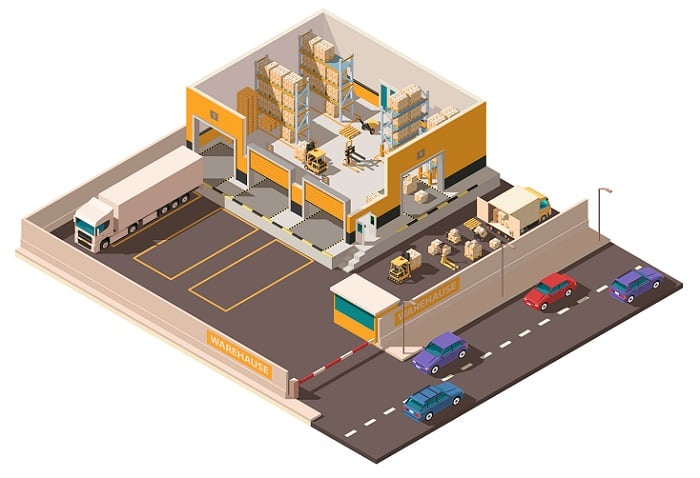Inside the walls of a manufacturing or storage facility, AI is used heavily to prevent shortages and bottlenecks. Learn about the algorithms used within various warehouse applications.
In previous AI-centric articles, we have explored the implications of optimizing different elements of the supply chain, starting with the scope of the broader distribution network before focusing specifically on transportation and yard management.
In this article, we delve deeper into the role that AI is playing in transforming warehousing tasks, including inventory management, layout design, and material handling. These technological advancements are already taking place in numerous markets and industries around the world. Regardless of operational scale and complexity, integrating AI-based solutions into warehouse systems is rapidly becoming critical for businesses to maintain a competitive edge.
AI in Inventory Management
Inventory management is a key process within a warehousing operation. It comprises different techniques aimed at meeting product demands by having the right amount of stock at the right time. Another important goal is to optimize inventory levels to reduce product storage costs.

Figure 1. AI plays a crucial role in transforming warehousing tasks.
Inventory management has traditionally relied on manual processes that are labor-intensive. For instance, manual physical counting requires a dedicated team and a window of production shutdown. Warehouse records and forecasts are based on historical data and they lack the flexibility to respond to changing conditions.
Modern AI solutions are rapidly transforming many of these practices. Thanks to the ability to process large amounts of data in real time, AI-enhanced warehouses can dynamically maintain the right balance of inventory levels and generate more accurate forecasts.
Now, let’s review some of the most significant AI algorithms applied to inventory management.
Reinforcement Learning (RL)
In a previous article, we talked about two primary approaches to analyzing data in AI: supervised and unsupervised learning. There is one more strategy with immense potential, perhaps less well-known. It is called Reinforcement Learning (RL).
RL is machine learning that employs a system of rewards and penalties to teach a model as it interacts with an environment. Imagine you are writing a computer program that will teach itself how to play Super Mario Bros. Your code has a set of rules and specific moves or actions that the main character can perform. The environment is the game itself, as well as the obstacles presented to the characters.
In the first iteration, your code attempts possible moves at random, continuing in this way until it fails. If (when) it fails, your code penalizes the action that caused it. If the code successfully reaches the goal, it rewards the actions. After doing this for many iterations, you could end up with a series of actions that lead to a perfect score and the fastest possible time to finish the game.

Figure 2. Reinforcement Learning rewards actions that lead to a successful outcome.
In the context of inventory management, RL can help find optimal inventory levels by continuously learning from its environment. Some examples of possible actions include scheduling shipments, storage consolidation, and location priorities. The environment is the warehouse itself. As the RL algorithm learns, it will reward the actions that lead to fewer stockouts and overstocks over the course of time.
Recurrent Neural Network (RNN)
Other AI algorithms we have reviewed in previous articles also have a significant impact on inventory management. For example, Recurrent Neural Networks (RNNs), which can help predict disruptions in the overall supply chain, can also predict disruptions within the walls of a warehouse.
AI in Layout Design Optimization
Layout design can greatly impact warehouse efficiency. It concerns the arrangement of product storage within specific areas. An optimal layout design reduces task times and bottlenecks.
Clustering Algorithm
A clustering algorithm, such as K-Means, can analyze product attributes and historical data to determine an efficient arrangement of storage based on attribute similarities and the likelihood of co-ordered items.

Figure 3. AI can help with the spatial planning and optimization of a storage area.
AI in Material Handling
Autonomous mobile robots (AMRs) are often (and increasingly) AI-based, relying on technology instead of manual input to deliver the most optimized results. Many of their functions rely on some of the most advanced algorithms available today.
Dijkstra’s Algorithm
Navigation and path planning are two of the most important characteristics of any AMR system. Within a warehouse, AMRs need to know where they are with respect to the system of coordinates. They also need to know what the safest and most efficient path ahead is. To do this, AMRs use algorithms like Dijkstra. This algorithm is specially designed to help find the shortest path within a network of roads by considering factors such as maximum speed allowed, path costs and penalties, and temporary traffic situations.

Figure 4. AMRs are advanced AI-powered material handling machines. Image used courtesy of Control.com
AMRs also leverage computer vision systems for navigation and object recognition. Vision systems enhanced with neural network processing logic help AMRs with object identification. This is how these vehicles can pick up or drop objects safely.
Reinforcement Learning for AMRs
Reinforcement Learning techniques are also important. RL helps an AMR system with efficient task allocation. A typical AMR system architecture includes higher-level applications that handle vehicle traffic management. In this context, RL helps with determining and allocating the most efficient task that a specific AMR can perform based on its status and the current conditions of the environment.
AI and Automation in Warehousing
There is simply no shortage of AI applications inside the AMR or the larger warehousing operation in general. It is important for businesses to consider embracing these technologies that have demonstrated significant gains in service levels.
Copyright Statement: The content of this website is intended for personal learning purposes only. If it infringes upon your copyright, please contact us for removal. Email: admin@eleok.com
